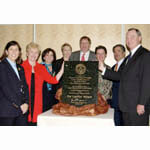
San Antonio (Oct. 12, 2004) – The University of Texas Health Science Center at San Antonio honored Tom Loeffler and his wife, Nancy, on Oct. 8 with the naming of the Loeffler Atrium at the Health Science Center’s new Children’s Cancer Research Institute. Tom Loeffler is a former member of the U.S. House of Representatives and former chair of The University of Texas System Board of Regents.
“Tom, few people have had the impact on Texas that you have had, not just as a Congressman, but as one of the top leaders in Congress, and not just as an adviser and friend to one president, but to many,” said Francisco G. Cigarroa, M.D., Health Science Center president. He called Loeffler “a great leader for education, and a great leader in the communitywide effort to bring this Children’s Cancer Research Institute to San Antonio.”
Loeffler, a cancer survivor, recalled the doctor’s pronouncement, “You have cancer,” as the “three most deafening words.” He and Mrs. Loeffler are among a group of community leaders who are supporting the new research institute. The naming of the atrium “is a great honor for Nancy and me,” he said.
Cyndi Taylor Krier, vice chair of the UT System Board of Regents, said she and Loeffler both worked for former U.S. Sen. John Tower in the 1970s. She recalled that Loeffler, a University of Texas football player for Darrell Royal and champion cutting horse rider, was about to make his first speech as a candidate for Congress at a home in San Antonio.
“There was a swimming pool in the back yard, and somebody got the idea to have Tom make his first speech on the diving board,” Krier said. “His legs were bending as he spoke. Jim McCrory of the San Antonio Express-News leaned over and said to me, ‘I can see the headline tomorrow: ‘Loeffler makes big splash.’”
That light-hearted remark proved to be prophetic. “He and Nancy have made many big splashes in the years since then,” Krier said.
Sharon Murphy, M.D., director of the Children’s Cancer Research Institute, underscored her commitment to make it a world-class research institute. She invited Ambassadors’ Circle members, who are headed by philanthropists Toby and Barbie O’Connor of San Antonio, to attend future events to hear about science conducted at the institute.
“Since February (2004), we have moved in four research groups (into the institute’s new building at 8403 Floyd Curl Drive),” Dr. Murphy said. “Recently, we have seen the acceptance of three more offers to researchers, one from Harvard, one from the Huntsman Cancer Institute at the University of Utah, and one from Research Triangle Park in North Carolina.” She said they are expected to arrive in January.

